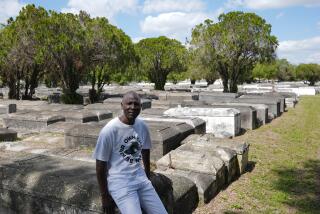Income Lags : Plot Sales No Gold Mine for Cemeteries
- Share via
Using simple arithmetic, a cemetery looks like a gold mine for a developer.
It would seem to take the condominium and resort time-share concepts a step “beyond,” if you’ll excuse the expression.
The typical cemetery plot sells for an estimated $500, and takes up about 30 square feet, at most.
“So you could get about 1,452 cemetery plots to the acre,” Robert Anson Steele, a Santa Ana real estate appraiser who has studied many cemeteries, said. “This sounds like a heck of a deal, but the problem is, you can sell only so many cemetery plots a year.”
Not Enought Income
“A small cemetery sells about 500 a year, and a large one, maybe 7,500.”
That may still sound good, but Steele said, “You can’t generate enough front-end activity to make it a profitable real estate venture. Most cemeteries don’t generate enough income fast enough to make for profitable land use.”
In other words, he said, “if you figure it on a unit basis, it’s a hellish price for land, but to make the equation mean anything, you must sell an awful lot up front.”
Cemetery plots are sold at need or pre-need, and with pre-need, cemeteries require a large sales force “out there canvassing the neighborhood,” as Steele phrased it.
“So the first 20% to 30% goes to pay those people. The cemeteries don’t get any money until after that, and then, most pre-need plots are sold on a five-year amortization basis. The proceeds come in over the next 4 1/2 years.”
Most Cemeteries Nonprofit
This might account for the fact that many, maybe most, of the 75,000 to 100,000 cemeteries in the United States are nonprofit--even some of the largest: Rose Hills and Forest Lawn, which is not nearly as large as Rose Hills in Whittier, with its 2,600 acres, but has 1,250 acres in its five locations.
Still, even nonprofit cemeteries must make money to maintain their grounds and develop new lawns and mausoleums, and Steele says they do this not so much through the sale of grave sites or plots but through “ancillary activities” such as selling flowers, markers, caskets, vaults and crypts.
Even niches and urns for cremated remains can be costly, though they generally run less than traditional graves and caskets, but cremation has had an effect on cemeteries, agreed Jack Springer, director of the Cremation Assn. of North America, in Chicago.
“Cremations have taken the pressure off the concern about running out of cemetery land,” he said, “but at the same time, the number of deaths has been increasing with an increase in the population, so the actual demand for space has remained about the same.”
Growing Trend
That demand may be growing, however. Joe Estephan of the Cremation Society of California, a 14-year-old cremation service based near L. A.’s Chinatown, said that he’s seeing a trend toward more cemetery burials of cremated remains.
“We’ve had about 50% buried at sea, but that percentage is decreasing,” he observed. “In the old days, those who were cremated were mostly drifters and people with no next of kin, but now more families are opting for cremation with niches and memorials in cemeteries.”
As for buying a niche or a grave as a real estate investment, Ruth Brockman of the Herman Shrager (cemetery broker) Co. in Studio City, echoed Steele:
“We don’t urge people to buy with the idea of speculating or making money on it, because you would have to hold it too long, but buying could be a good investment as a place to hold and use, because prices for niches, crypts and graves are going up, like everything else.”
(Even so, a “Guide to Cemetery Purchases,” issued by the state Cemetery Board in Sacramento, warns that a disadvantage of buying pre-need is that “if you decide to sell and are under a time limitation, you may have to sell for less than you originally paid.”)
Optional Exchange Program
There are about 200 licensed cemetery brokers in the state that provide a secondary market for such property. Otherwise, many cemeteries, like Rose Hills, participate in an optional exchange program with other cemeteries throughout the country for purchasers who move more than 75 miles away.
The program enables these people, who bought through pre-need at Rose Hills, to resell and buy somewhere else.
Land that is not used for burials, even if it has been dedicated as a cemetery, can be used for something else, Steele said, so there have been cases where cemetery land has been sold for high-end residential and other types of development.
“County assessment tax laws favor dedicating cemetery properties. The owner is not taxed on it,” he said. “So, most cemeteries have more land dedicated to cemetery use than they will ever use.”
(Proposals to dedicate cemetery land have been greeted, in many instances, by an uproar from people owning adjacent properties, but Steele asserts that “there is no evidence that cemeteries in general hurt value.”
Added Tax Benefit
On the contrary, he says, because most cemeteries are governed by associations and have endowment-care funds to maintain them in a park-like manner, “it’s the other way around.”)
Cemetery owners who are limited partners got an added tax benefit this year, Stan Ross, co-managing partner, Kenneth Leventhol & Co., Los Angeles, pointed out:
“If the owner is a limited partner and is receiving passive income (from the cemetery), that could be held to offset other real estate passive losses.
“It’s a neat slant, even though a cemetery, from an income tax point of view, is nothing unusual. It’s a business and a generator of cash flow.”
More to Read
Inside the business of entertainment
The Wide Shot brings you news, analysis and insights on everything from streaming wars to production — and what it all means for the future.
You may occasionally receive promotional content from the Los Angeles Times.










